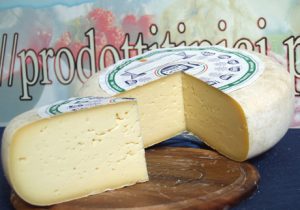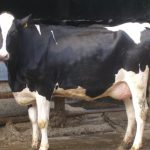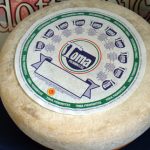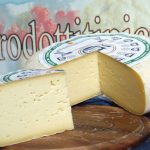
Name
Toma Piemontese PDO
Seal of quality
Protected Designation of Origin with Reg. EEC 1263 dated 01/07/1996.
Description
This cheese comes in circular forms with flat or semi-flat faces and a diameter of between 15- 35 cm and a circumference height ranging from 6 – 12 cm ; consequently, even the weight of each whole cheese is extremely variable and ranges from 1.8 kg to 8 kg . The gustatory characteristics of Toma Piemontese depend on whether it has been produced traditionally with whole milk, or if it is of the semi-fat version with skimmed milk.
In the first case, the rind is elastic and smooth and its colour goes from deep straw-yellow to reddish brown according to its seasoning, whereas the cheese itself is straw-yellow with tiny well-distributed eyes; its flavour is sweet and agreeable, with a delicate fragrance. In the semi-fat version, the rind is not very elastic and has a rough aspect, its colour ranges from deep straw-yellow to reddish brown, the cheese itself is straw white with tiny eyes and its flavour is intense and harmonic, and a fragrance that becomes more characteristic with seasoning.
Only cow’s milk is used, coming from at least two consecutive milkings left for at least 12 hours for the whole-milk cheese, and up to 24 hours for the semi-fat cheese. After surface skimming, the milk is poured into a boiler at a temperature of 32°-35° C to which calf rennet is added.
The curd obtained from this at first is broken down roughly, often turning over the higher layer that has cooled; then there is a short pause favouring a first massive whey discharge. Further breaking down of the curd follows, often accompanied by further heating, which can be at a cooking temperature of between 44° and 48° C. Breaking down continues until the lumps have reached the size of a corn for the whole-milk cheese or the size of a grain of rice for the semi-fat cheeses, after which the mass is left to rest for a few minutes for the curd to deposit on the bottom, separating from the whey.
The curd collected is put into “fascere” (moulds) and, after a first phase of pressing, having let excess whey is left todrip in suitable rooms; during this interval, varying from 3 to 24 hours for whole-milk cheese and from 3 to 72 hours for semi-fat cheese, the cheese is turned over several times. The next step is salting, traditionally carried out by hand, with coarse salt on the two faces alternately for no longer than fifteen days, or in brine for 24 – 48 hours according to the size of the cheeses. Seasoning takes place in traditional cellars with humidity of about 85% and at a temperature ranging from 6° to 10°. During these stages the cheeses are turned over several times, and the flat faces sometimes washed with a water and salt solution. The minimum duration of this period is sixty days for whole cheeses weighing over 6 kg and fifteen days for cheeses of a lower weight.
Nutritional characteristics
Follows the nutritional characteristics of Actinidia of Toma Piemontese.
| unit of measurement | Toma Piemontese | |
|---|---|---|
| protein | g/100 g prodotto | 26.8 |
| carbohydrates | g/100 g prodotto | <1 |
| sugar | g/100 g prodotto | <1 |
| fat | g/100 g prodotto | 29,3 |
| di cui saturi | 18 | |
| di cui trans | 2 | |
| cholesterol | mg/100g di prodotto | 93 |
| Nutritional value | Kcal | 371 |
| Kjoule | 1540 | |
| calcium | mg/kg | 7670 |
| iron | mg/kg | 3,9 |
| sodium | mg/kg | 5200 |
| Vit A | mg/kg | 3,1 |
| Vit C | mg/kg | < 1 |
Area of production
It is the only PDO cheese the production of which concerns the entire regional territory, since the place of origin of the milk, the processing, seasoning and elaboration of the Toma Piemontese cheese includes the entire administrative region of the provinces of Cuneo, Turin, Biella, Vercelli, Novara and Verbania and some communes in the province of Asti (Bubbio, Buttigliera d’Asti, Cassinasco, Cellarengo, Cessole, Dusino San Michele, Loazzolo, Monastero Bormida, Roccaverano, Mombaldone, Olmo Gentile, San Giorgio Scarampi, San Paolo Solbrito, Serole, Sessame, Valfenera e Villanova d’Asti) and Alessandria (Acqui Terme, Terzo, Bistagno, Ponti e Denice).
History
Piedmont has always been a land of great cheeses and has linked it name with many typical productions. Amongst these there is certainly Toma, which takes its origin from the mountain pastures and throughout the centuries has gradually come down to the valleys. It is the most widespread and probably the oldest cheese, and is certainly the cheese that best expresses the character of a land, as its name indicates, created from a deep inseparable bond with the mountains surrounding it.
History and language teach us how old and deeply rooted this bond is between Piedmont and its Toma.
Production and consumption of cheese in the Piedmontese area were first documented in the 11 th century, appearing above all in the “pastus” distributed to the poor or to the subordinate workers, thus confirming the hypothesis of one of its uses, characteristic of the people’s classes, at least in these initial periods. It would seem that particularly spicy cheeses known as “cheeses of the poor” were more popular, as Pantaleone da Confienza wrote in the Summa lacticinorum:
” […] while ageing, such fermentation occurs that they do gain in flavour, but very spicy flavour, so much so that it is said they are useful to the poor, firstly, because of their hot flavour, they eat very little of it . secondly, it is said to be useful to the poor because in the dishes prepared by them, thanks to the sharp taste of the cheeses, there is no need for spices and salt”.
In the centuries that followed, the consumption of cheese spread to all social classes, overcoming the strictness religious principles that forbade the consumption of cheese on “days without meat”, and the initial prejudice of doctors and aristocrats, who considered it a heavy plebeian cheese. This attitude lasted, but gradually fading, until the beginning of the 17 th century
Furthermore, we must remember that as time went by, the typically mountain and valley Piedmontese Toma cheese extended also to the plains, thanks to, or rather, to the credit of the “margari” (Piedmontese breeders and milk sellers), as recalled, amongst others, by Francesco Confienza in one of his memoirs entitled “I margari della Provincia di Torino”. However, merit undoubtedly goes to Piedmont for having ennobled the word Toma.
In the popular tradition, the word Toma was frequently used in combination with a geographic indication (Toma di Ormea, Toma di Biella, Toma di Susa, Toma di Piode, Toma di Boves, Toma di Lanzo, etc.) to represent similar products and, in all cases, inspired by the same origins. As a consequence, since the area of production represents a vast area of the Regione Piemonte, and with complete respect for tradition, the adjective Piedmontese has been indissolubly linked with the name Toma, thus forming the “Toma Piemontese”.
In 1982, Toma Piemontese obtained AOC status and later, in 1986, PDO status. In 2003, the “Consorzio di Tutela del Formaggio Toma Piemontese” was founded and officially recognised, with the purpose of promoting and protecting this typical Piedmontese cheese.








